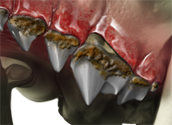Does your pet have bad breath? Unfortunately, most pets do and this is not normal. The foul odor you smell is caused by an infection in their mouth. The most common cause of infection in your pet’s mouth is periodontal disease, which affects over 75% of pets over 2 years of age. Periodontal disease is a progressive and irreversible loss of the structures surrounding the teeth (see image A) caused by chronic infection and inflammation in the mouth. When your pet eats, residual food particles in the mouth promote growth of bacteria. The bacteria form a slime layer, known as plaque, which attaches to the teeth and hardens to form tartar and calculus (see image B). Periodontal disease is graded by severity
Grade 1: Gingivitis only. No loss of support tissues.
Grade 2: Less than 25% tissue attachment loss.
Grade 3: 25-50% tissue attachment loss. Gum recession may lead to tooth root exposure. Affected teeth may begin to be mobile in the sockets.
Grade 4: Greater than 50% tissue attachment loss. Mobile teeth due to significant loss of supporting tissues.
Early treatment is best to prevent pain, tooth loss and expensive treatments. Left untreated, periodontal disease may lead to:
● Chronic pain from infection and inflammation
● Decreased quality of life
● Decreased appetite and weight loss
● Tooth loss due to loss of supporting tissues around teeth
● Distant organ (e.g.: liver, kidneys, heart valves) damage from bacteria showering from the mouth to the bloodstream
● Adverse behaviors caused by pain
The first step in treating periodontal disease requires cleaning the teeth and surrounding tissues. Because your pet will not lie down quietly for a dental cleaning, general anesthesia is required. To prepare anesthesia, your veterinarian will do a thorough examination of your pet, perform blood work and discuss the procedure with you. Your pet will be monitored closely throughout the entire procedure: your pet’s safety is our primary concern. After the teeth are cleaned, X-rays will be taken of the teeth to check for pathology hiding below the gum line (see image C). Your veterinarian will discuss with you any other procedures that may need to be performed.






